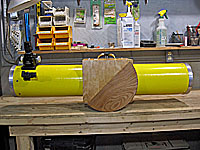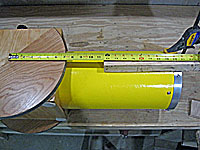

Finding the Balance Point
The next item we need to build is the rocker box. However, we lack one key piece of information at this time - how far below the altitude bearings does the tube stick out? On this page we will obtain that information.
Getting Ready to Balance
Insert your tube into your cradle, taking a guess at where it will balance. Then put your heaviest eyepiece in the focuser, and make sure all tube mounted accessories like finders are on the tube. We want the top of the tube to be in its heaviest configuration, because that will cause the back of the tube to stick out the farthest to achieve balance.
Balance the tube in the Cradle

If you have followed our advice on the size of altitude bearings, they no doubt stick out below the cradle, and the scope will rock on them on a flat surface such as a table, workbench or hard floor. If for some reason this is not the case, you will have to arrange for some wood blocks or other objects for altitude bearings to balance on.
Now, slide the tube in the cradle until until the entire assembly is in balance, or very close to it. If you have to err, err on the side of the back of the tube being just slightly heavier (so that its end rests on the surface). Note that when the altitude bearings are riding on Teflon pads in the rocker box, balance will be much easier to obtain, but we need the tube length information in advance of building the rocker box.

Measure
No that the cradle/tube assembly is in balance, you need to measure from the back end of the tube to the center mark on the cradle/altitude bearings (the center of rotation, previously the center of the disk that became the altitude bearings). Write this number down, we will use in to make sure our rocker box has adequate height so that your telescope can point at the zenith without colliding with the bottom of the rocker box.
We measured 21¼ inches from the rotation point of the altitude bearings to the back of the tube (parallax in the photo makes this look shorter).
Now we can design and build the rocker box...
Previous: Altitude
Bearings Next: Rocker Box
Back to the Build a Dobsonian Master
Index